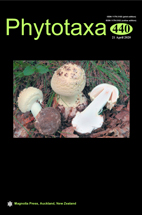Abstract
We analyzed mitochondrial COI-5P and plastid rbcL sequences from specimens of Aphanta collected from China and Japan and accessed morpho-anatomical data in detail. The results revealed the presence of a novel species of this genus, Aphanta asiatica, described here. Aphanta asiatica was characterized by a turf-forming habit of thalli with anastomosing branches, and a thick, wide, and flattened axis with subpinnate to pinnate branches, and characterized by its robust and branched prostrate system bearing complex peg-like haptera which were either typical or non-typical. Rhizoidal filaments were abundant in the inner cortex and distal ends of the axis, and interspersed in the medulla. Tetrasporangial and spermatangial sori were produced on the terminal ends of the branchlets and axes. Tetrasporangia were irregularly arranged and cruciately divided, and spermatangia were cut off from the outermost cortical cells. In phylogenies of the COI-5P and rbcL sequences, A. asiatica was closely related to Aphanta pachyrrizha. In conclusion, the present study is the first to document reproductive structures in, and contribute further to our understanding of, the genus Aphanta.

